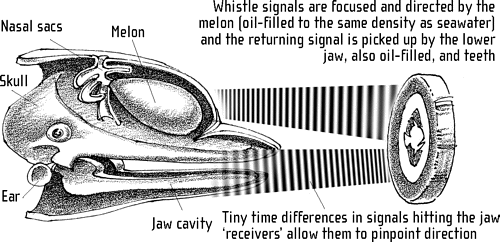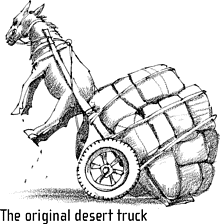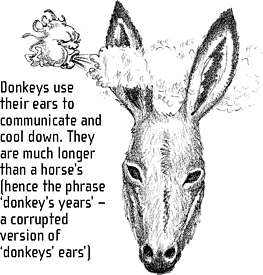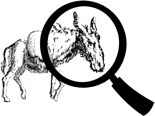Read The Book of Animal Ignorance Online
Authors: Ted Dewan
The Book of Animal Ignorance (11 page)
W
e haven't done dolphins any favours. The wilder shores of hippy speculation they have inspired â their brains are more complex than ours; their language is more sophisticated; they have a society dedicated to peace and free love; they are extraterrestrials with fins â reveal more about us than them. This is not to undermine their utter fabulousness, just to remind us that they are wild animals, with their own agendas and priorities. They can do things we can only dream of (and â just maybe â they feel the same about us).
A dolphin's skin is
shed and replaced
every two hours
to maximise
streamlining
.
Take echo-location, their system of marine navigation. Dribble a teaspoon of water into a pool and they will locate the sound with pinpoint accuracy. They can discriminate between objects made from wax, rubber or plastic. They can even tell the difference between identical-looking brass and copper discs. Fish, not noted for their quietness (herrings fart non-stop), don't stand a chance.
Their âlanguage' skills are more difficult to assess. Dolphins are famously talkative â despite having no vocal chords. The clicks, whistles, groans, squeals and barks all come from sacs in their nasal passages â as many as 1,200 per second. Each dolphin has a unique âsignal whistle', an âI'm Flipper' tag, which it repeats constantly. They also imitate other dolphins as a way of gaining their attention, rather in the same way as doing an exaggerated impression of a friend in a crowded bar means they are more likely to turn round. The whistle signals show that they communicate, but they are a long swim away from being a language.
Dolphin play is highly complex, and they learn fast. They have a striking ability to follow extraordinarily complicated human commands, and can recognise themselves in a mirror. They can even use tools: when hunting among sharp coral they attach bits
of sponge to their snouts as safety masks. Legends of their helpfulness to gods and humans are threaded through Greek and Roman myth and contemporary accounts of dolphin ârescues' are common. In small fishing communities, dolphins are known to herd shoals of fish into nets in return for a few thrown back and a friendly wave. It's hard not to love their big smiley faces.
But there is another side. For all the foreplay and nuzzling, females are frequently coerced into sex by groups of males. Schools of dolphins batter porpoises to death for no obvious reason, and occasionally practise infanticide. In a comprehensive study of wild dolphins that seek out human company, three-quarters showed aggression, which sometimes led to serious injury, and half indulged in âmis-directed sexual behaviour' with buoys and boats as well as humans. Given that an average male bottlenose weighs 40 stone and has a foot-long, solid muscle penis that ends in a prehensile hook agile enough to catch an eel, you wouldn't want to give off the wrong signals.
This same report concluded that contact with us almost always means injury and suffering for the wild dolphin. It's worth bearing that in mind when considering the benefits of âwildlife tourism' and âdolphin therapy'. Of course, the idea of âswimming with dolphins' is attractive and there is evidence that it does have therapeutic value. But we gain just as much (and maybe more) by standing on a boat watching them through binoculars, revelling in the fact that they are where they belong, doing what they do best.
NOSE SONAR

D
onkeys' milk is a wonder substance. Country people in India have always sworn by it as a baby food, but chemical analysis has recently revealed it is full of oligosaccharides, carbohydrates with powerful immuno-stimulant properties. It has been tested in cases of AIDS and cancer, and some claim the milk has an effect similar to Viagra.
Donkeys were first domesticated in Ethiopia and Somalia about 6,000 years ago. The modern donkey is the same species as the African wild ass (
Equus asinus
). It is the only domesticated animal to have originated in Africa. They were used for transport long before horses, which were originally bred in Asia purely for their meat.
Ancient Egyptian tombs show that donkeys were the Porsches of the Nile delta: the more donkeys, the higher your status. Herds of a thousand or more were not uncommon. With donkeys came trade: their ability to carry 30 per cent of their body weight without complaint opened up the ancient world.
The word âdonkey' is surprisingly recent â it wasn't around when the King James Version of the Bible was written in 1611 â and probably originated in the late eighteenth century to avoid the growing confusion between âass' and âarse'. According to the
Oxford English Dictionary
, âdonkey' was originally pronounced to rhyme with âmonkey' and is thought to come from âdun', meaning brown or grey.

A male donkey is called a jack or jackass; a female donkey is called a jenny or donkeyess. The personality of a donkey is called their donkeyship.
Donkeys have sixty-two chromosomes (sixteen more than humans) and can be crossed with horses or zebras. The offspring of a male donkey and a female horse is called
a mule. The male mule is called a john and a female mule a molly. The offspring of a male donkey and a female horse is called a hinny. Zebras crossed with donkeys are called zeebrasses and zonkeys. Only 1 in 10,000 of these hybrids are fertile.
A donkey is like a
housewife. In fact,
the donkey is a
shade better, for
you'll never catch the
donkey being
dis
loyal to his mas
ter.
RAJASTHANI
SCHOOL TEXTBOOK
Donkeys have a reputation for stubbornness; in fact, they are highly sensitive to danger and rather sensible. Unlike horses, which bolt when spooked, donkeys stand rooted to the spot, braying loudly, and are the only animals of their size that won't back down when confronted by a lion. In Africa, guard-donkeys are used to protect cattle. Dogs are instinctively scared of donkeys: they have a surprisingly accurate kick.

By 1939, there were only a hundred donkeys left in England. There are now about 10,000 â 800 are licensed to work on beaches and 75 per cent of them live in donkey sanctuaries.
Every donkey has a dark cross on its back that is supposed to date from Christ's entry into Jerusalem. Before it became associated with Christ, the donkey was identified with the Egyptian sun god Ra, and Dionysus, the Greek god of wine and theatre. Until the mid-nineteenth century, Santa Claus always rode a donkey.
Dead donkeys are lucky. You should jump over them three times. Or make a sandwich out of their hair to cure a cough. Or sprinkle their toenail clippings over your enemies. Or pop their heads in the oven:
cephaleonomancy
is divination using a roast donkey's head. In 1869 a donkey was served for dinner at high table in Sidney Sussex College, Cambridge. One of the dons remarked that it tasted ârather like swan'.
E
agles belong to the family
Accipitridae
, from the Latin
accipiter
, a âbird of prey'. In English, an accipiter is a ânose-bandage' from its resemblance to the beak or claw of a hawk. Not everyone agrees what an eagle is; no one knows how eagle species are related to one another and the evolution of eagles is poorly understood. Eagles are defined by what they are not. According to one professional definition, an eagle is âa large or very large diurnal raptor which is not a kite, vulture, hawk, buzzard or falcon'. In all eagle species, females are larger than males: the more aggressive the species, the larger the discrepancy.
Eagles lay
clutches of two
eggs, but the first
chick to hatch
usually kills its
sibling, even
when food is
abundant. No one
knows why
.
An eagle's eye can be up to twenty times larger in proportion to its body than a human eye. They are so big in their sockets that there is little room for them to move: like owls, an eagle has to move its whole head to look round. Nonetheless, the visual acuity of an eagle is up to eight times better than a human's. An eagle can spot a rabbit from 2 miles away. As an eagle swoops down on its prey, the muscles in its eyes continually adjust the curvature of the lens to maintain sharp focus and accurate depth perception throughout the attack. Eagles of the soaring variety must wait until the air is warm enough to create thermals. The heavier the eagle, the later in the day it begins to hunt. Eagles, however, can hardly be described as heavy. A golden eagle (
Aquila chrysaetos
) is 7½ feet wide but weighs less than 9 pounds. A bald eagle's (
Haliaeetus leucocephalus
) feathers weigh more than twice as much as its bones. An eagle's dive reaches speeds of 200 mph, but only about one in four such attacks are successful.
TIPTOE TERMINATOR

Some eagles have given up on the exhausting business of
roaming the azure yonder, falling like a stone and missing. They prefer to sit about biding their time. Many reptile-eating (and some fish-eating) eagles perch in trees in a lordly manner, waiting for their prey to scuttle by. They then drop straight onto them from a sitting position. The lesser-spotted eagle (
Aquila
pomarina
) neither falls like a thunderbolt nor watches imperiously. It walks around looking for frogs to eat. Eagles will eat anything, dead or alive. Not just rodents, reptiles, birds and fish but ants, termites, dead elephants and whales, locusts, baby seals, crabs, snails, sloths, snakes and monkeys. Martial eagles (
Polemaetus bellicosus
) eat baboons. Golden eagles enjoy caribou calves. Steller's sea eagle (
Haliaeetus pelagicus
) is partial to seal pups. Crowned hawk eagles (
Stephanoaetus coronatus
) eat mandrill monkeys and can kill a bushbuck four times their own size. Both serpent eagles and snake eagles catch snakes. Serpent eagles fly off with the snake dangling from their legs, whereas snake eagles swallow them whole, head first. They then fly back to the nest, where the snake eaglet grasps the tail of the snake and hauls it out of its parent's mouth like a string of handkerchiefs. On a less grisly note (and despite its unnerving name), the favourite food of the Vulturine fish eagle (
Gypohierax angolensis
) is fruit from the oil-palm tree.
The two-headed eagle
featured on many
European flags was a
symbol of the Byzantine
empire: one head
represented ancient
Rome, the other, ânew
Rome', or Constantinople
.



